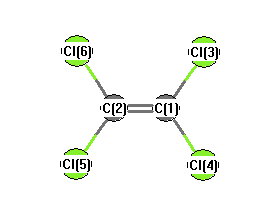Vibrational Frequencies calculated at B97D3/6-31G*
| Mode Number |
Symmetry |
Frequency
(cm-1) |
Scaled Frequency
(cm-1) |
IR Intensities
(km mol-1) |
Raman Act
(Å4/u) |
Dep P |
Dep U |
|---|
| 1 |
Ag |
1574 |
1543 |
0.00 |
|
|
|
| 2 |
Ag |
438 |
429 |
0.00 |
|
|
|
| 3 |
Ag |
239 |
234 |
0.00 |
|
|
|
| 4 |
Au |
92 |
90 |
0.00 |
|
|
|
| 5 |
B1u |
752 |
737 |
82.15 |
|
|
|
| 6 |
B1u |
313 |
307 |
0.08 |
|
|
|
| 7 |
B2g |
502 |
492 |
0.00 |
|
|
|
| 8 |
B2u |
855 |
838 |
250.50 |
|
|
|
| 9 |
B2u |
176 |
173 |
0.96 |
|
|
|
| 10 |
B3g |
938 |
919 |
0.00 |
|
|
|
| 11 |
B3g |
337 |
330 |
0.00 |
|
|
|
| 12 |
B3u |
287 |
281 |
0.55 |
|
|
|
Unscaled Zero Point Vibrational Energy (zpe) 3251.2 cm
-1
Scaled (by 0.9804) Zero Point Vibrational Energy (zpe) 3187.5 cm
-1
See section
III.C.1 List or set vibrational scaling factors
to change the scale factors used here.
See section
III.C.2
Calculate a vibrational scaling factor for a given set of molecules
to determine the least squares best scaling factor.
Charges, Dipole, Quadrupole and Polarizability
Charges from optimized geometry at B97D3/6-31G*
Charges (e)
| Number |
Element |
Mulliken |
CHELPG |
AIM |
ESP |
| 1 |
C |
-0.187 |
|
|
|
| 2 |
C |
-0.187 |
|
|
|
| 3 |
Cl |
0.094 |
|
|
|
| 4 |
Cl |
0.094 |
|
|
|
| 5 |
Cl |
0.094 |
|
|
|
| 6 |
Cl |
0.094 |
|
|
|
Electric dipole moments
Electric dipole components in Debye
(What's a Debye? See section
VII.A.3)
| |
x |
y |
z |
Total |
| |
0.000 |
0.000 |
0.000 |
0.000 |
| CHELPG |
|
|
|
|
| AIM |
|
|
|
|
| ESP |
|
|
|
|
Electric Quadrupole moment
Quadrupole components in D Å
| Primitive |
|---|
| | x | y | z |
|---|
| x |
-60.657 |
0.000 |
0.000 |
| y |
0.000 |
-57.886 |
0.000 |
| z |
0.000 |
0.000 |
-59.387 |
|
| Traceless |
|---|
| | x | y | z |
|---|
| x |
-2.020 |
0.000 |
0.000 |
| y |
0.000 |
2.135 |
0.000 |
| z |
0.000 |
0.000 |
-0.115 |
|
| Polar |
|---|
| 3z2-r2 | -0.230 |
|---|
| x2-y2 | -2.770 |
|---|
| xy | 0.000 |
|---|
| xz | 0.000 |
|---|
| yz | 0.000 |
|---|
|
Polarizabilities
Components of the polarizability tensor.
Units are
Å
3 (Angstrom cubed)
Change units.
| |
x |
y |
z |
| x |
4.137 |
0.000 |
0.000 |
| y |
0.000 |
11.674 |
0.000 |
| z |
0.000 |
0.000 |
12.302 |
<r2> (average value of r
2) Å
2
| <r2> |
362.865 |
| (<r2>)1/2 |
19.049 |
